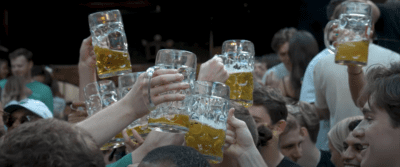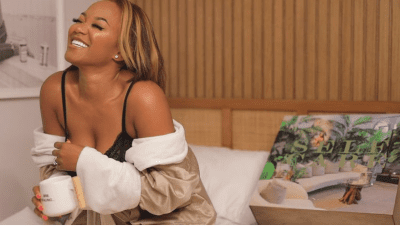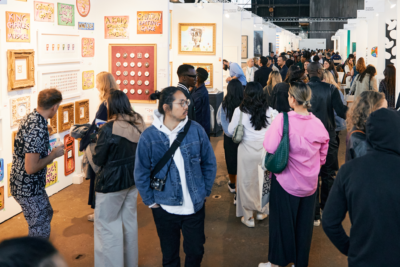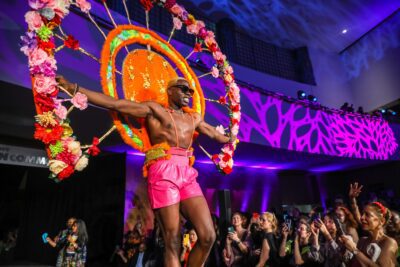Photo illustration by Johansen Peralta
A doo-wop dignitary remembers Brooklyn at the birth of rock ‘n’ roll
Kenny Vance witnessed history at the Paramount, opened for the Beatles, and has made a new doc about a lost era
Like what you’re hearing? Subscribe to us at iTunes, check us out on Spotify and hear us on Google, Amazon, Stitcher and TuneIn. This is our RSS feed. Tell a friend!
Kenny Vance may not be a household name, but his impact on American culture and music specifically is indelible and inescapable if, sadly, somewhat invisible.
A Brooklyn kid, born in Flatbush in 1943, he came of age right along with rock and roll. He grew up around icons of doo-wop like fellow Brooklynites Little Anthony and the Imperials and the Jive Five.
A formative childhood memory of his was seeing pioneering disc jockey Alan Freed’s rock ‘n’ roll revue in 1956 at the Paramount Theatre in Downtown Brooklyn (years before his payola scandal). Vance himself would come away from that concert transformed. At just 15 he co-founded the singing group Jay and the Americans, who were ultimately signed by the legendary songwriting duo Jerry Leiber and Mike Stoller. Before he was 20 the group was scoring hits like “She Cried” and opening the Beatles and The Rolling Stones on each of their first U.S. tours.
Later in his career Vance would become a music supervisor on classic films including “Animal House” and “The Warriors.” He was very briefly the music director at Saturday Night Live. And he also basically discovered Steely Dan.
This week Kenny Vance is our guest on “Brooklyn Magazine: The Podcast.” Now 79-years-old, Vance has recently put together a documentary about the lost first generation of rock and roll’s earliest stars from before the British Invasion. The film is called “Heart & Soul” and is a love letter to the bands he idolized as a kid — and features interviews with a few of their surviving members. The fact that it even exists is something of a miracle: The interviews he conducted were nearly washed away during Superstorm Sandy a decade ago, when his house in the Rockaways was completely demolished.
We talk about that movie, those early groups who opened the door for the revolution that followed. We talk about not getting paid. And we talk about Brooklyn, back in the day.
This interview has been edited for concision and clarity. You can listen to it in its entirety in the player above or wherever you get your podcasts.
Let’s start at the beginning. You were born in Brooklyn. You were there in the ’50s, the Brooklyn of the Dodgers. What was your childhood like? You were in Flatbush?
So your aunts would come over, and they had a certain kind of perfume on, and they had certain hats and coats and things like that. And as a kid you were relegated to the side of the room. And now that’s completely different. There’s an intermingling of no matter what age you are. But in those days, if you were a kid, you were seen but not heard. And what happened was, I guess when I was about maybe 13 or 14, Alan Freed came on the radio.
I was going to get to him, the famous early rock and roll disc jockey.
There was a failing radio station, WINS, 50,000 watts. They brought him in from Cleveland, and he went on the air, and it was just it. One person would say, “Check this out.” And within a couple of months, the guy had created a revolution. I remember one day he said that he was going to have a rock and roll show, and no one even knew what that was, but he was going to have it at DeKalb Avenue and Flatbush at the Brooklyn Paramount Theatre.
And when you say rock and roll show, you mean a concert, like a revue?
A revue. He had on it some of the groups that I have in the film, which are The Dubs. He had Frankie Lymon and the Teenagers. He had the Heartbeats. He had the Velours from Bedford-Stuyvesant. He had Chuck Berry from St. Louis. He had Screamin’ Jay Hawkins.
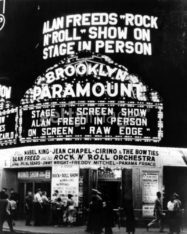

The Paramount in the 1950s
We’re talking 1956, Downtown Brooklyn, Paramount Theatre, all of these people who are legendary now. This was a fresh, new scene. You’re what, 13 years old?
Fourteen, 15. And what happened was that you took the subway down Flatbush Avenue and you got out at DeKalb Avenue, and you saw thousands of kids. The police are on horseback, and they have the barricades and everything. And you just couldn’t believe what you were seeing, and then you went in and the curtain went up. The Brooklyn Paramount was a whole block. It wasn’t like some dump that they’re having this revue in. They’re having it at the premier theater in Brooklyn, and the curtain went up and you see all the opulence and the gargoyles on all sides of the theater. And you’re in this palace. And then he starts bringing these acts out one after the next. You’re just transformed. And then, of course, the show is over, and you go home to Bedford Avenue, you have plastic slip covers on the furniture.
And your head is spinning, I’m sure.
Your head is spinning, exactly. That’s certainly an early memory of Brooklyn for me, just being part of that.
That’s a formative, powerful memory. You’re 14 whatever years old. You see all of these people who go on to become stars in their own right. This is not rock and roll per se as we know it. It’s the early germs. When do you start doing music in your own right? Because you have an incredible musical career of your own. You started your first group at 15, It’s all vocals. How did that start? You have to learn how to harmonize. What’s your early making music [memory]?
We listened to the songs on Alan Freed. We didn’t play instruments. We were emulating the vocal groups that had preceded us, like the Moonglows, the Flamingos, the Five Keys, Sunny Til and the Orioles, The Cadillacs. And so we would go down in the subway because it made you seem professional. It had the echo.
Yeah, the acoustics and the tile, right?
The tile. So we would go down on the subway, and we didn’t know harmony. We didn’t know music. But you figured out how to sing a triad, or you’d have three different people on three different notes, and there was a blend. And all of a sudden there was immediate eye contact because we were flying. And that was the impetus to actually start a group. And we actually would learn, [sings] “Walking Along,” “Gloria.” I’m sort of hoarse.
The voice is incredible. Maybe you’re not feeling it at the moment, but in the film you hit these high notes. You certainly don’t see it coming. Do you still sing a lot?
The pandemic really shut everybody down. We didn’t do it for a couple of years, but we just fairly recently started to crank it up again. I see that I’ve probably lost a little bit of the top part, but I think that if we do it more often, I’ll be able to get back to it. That just reminded me: After Alan Freed and everything, then it became more mainstream. And so all kinds of people had it. Then I remember being invited to a make out party in somebody’s basement. You went down there, and you really didn’t know what to expect because everybody was uptight.
Nervous, sure.
Nervous. But what happened was all of a sudden songs like “Earth Angel” by the Penguins, “In the Still of the Night” by the Five Satins would come on. And the girls were so motivated by that. It was a sensual feeling, and they started to approach the guys. And before you know it, the whole room was just swaying to these songs and dancing close to a girl at some point in time. It never got better than that.
The movie is really a love letter to these guys who influenced you. You’re interviewing Eugene Pitt from The Jive Fives. He’s talking about dances in the park and singing at the Kingsborough projects in Crown Heights. You’ve got Little Anthony, I love Little Anthony and the Imperials. He’s talking about growing up in Fort Greene projects. I don’t think I realized these guys were from around here. You yourself are from Flatbush. Talk about the role that Brooklyn plays in this chapter of American music because the influence is outsized.
I’m going to tell you a story that may answer it. I did a movie called “American Hot Wax.”
You were the music supervisor later in your career.
It was 1976, ’77. I wound up going to California. One of the big parts of the movie was recreating the show at the Brooklyn Paramount. Well, I couldn’t have asked for a better job. I said, “Yeah, I could do that.” And I put the band together. Tim McIntire played Alan Freed with the plaid sport coat. In the movie I created a girl’s group. I created the Frankie Lymon prototype. We hired Jerry Lee Lewis and Chuck Berry and Screamin’ Jay Hawkins. And so I got to spend that time with them backstage at the Wiltern Theater on Wilshire Boulevard.
And I’m sitting with Chuck Berry for a couple of weeks. And he was very not forthcoming, but as time went by, and he saw that I actually got the right band for him and that it was sounding great. He says, “I got a call to come to Brooklyn,” and he says, “I thought there’d be something in it.” So I envision him at this point taking a bus to Brooklyn, and I envision him walking down Flatbush Avenue with his guitar case to the Brooklyn Paramount Theatre. And when he got there, his dressing room was on the 10th floor. He’s telling me this. And he went up and there was a line of people, like I described before, outside that went around the block. And when he got there, he saw a building that was the size of a whole block that he went in there, which he didn’t know what was going to happen. And none of them did. But when those guys came out on the stage, that audience at that moment in Brooklyn let them know who they were. And they all of a sudden were transformed into who they really were and who they would become.
They became stars, superstars.
Exactly. The Penguins, they came out and they became stars at that moment, and so did they all. And that became the prototype for what wound up happening historically for the next 60, 70 years. It’s got to be that long.
And you start singing yourself. When did you start recording with Jay and the Americans? Because you had hits.
We were probably the most successful group that ever came out of Brooklyn.
That’s a big statement.
Is it true?
Ever? I don’t know. There’s Neil Diamond, but he’s not a group. There’s Jay-Z, but he’s not a group.
Carol King.
I hear what you’re saying.
We were lucky enough to go to the Brill Building in Manhattan, the four of us, Jay, Sandy, Howie, and me. We have a meeting with Jerry Leiber and Mike Stoller who produced Elvis Presley. The Coasters. Wrote “Yakety Yak,” “Charlie Brown,” “Searchin’,” and “Love Potion No. 9.”
Legends.
They were unbelievable. And we’re there. Our knees were knocking, and we sang a capella. And they liked it because this guy, Jay Traynor was killer. If you listen to our second record that Jerry and Mike made with us, “She Cried,” you hear the performance of a 17-year-old kid just killing you. That started our career making records with Jerry Leiber and Mike Stoller.
That was peak Leiber and Stoller, too. What was working with them like? How were they as humans?
Jerry was just so lit up and so warm. He was the lyricist. [Sings] “I took my troubles down to Madam Ruth, you know the gypsy with the gold [capped-tooth]. She had a shop down on 34th and Vine selling little bottles of –”
“Love potion number nine.”
He was that guy. And Mike was more of a blues guy, like the jazz guy. So he was a little more reserved, but Jerry was just beautiful. And the two of them collaborated in the studio. They came there, and they made sure, okay, this is the right tempo, this is the right stuff. And they had an arranger. They had Sam Applebaum was the arranger for the Drifters, and our arranger at that time was Gary Sherman. But it was just being a kid. I was 17 myself, and we were sort of let into a secret world. If it wasn’t for them, we never would’ve had a hit. We never would’ve made that kind of a record.
I mean, you mentioned “She Cried,” which is a great song. If our listeners haven’t heard it, it’s on Spotify, but you’re recording in the early ’60s then. “She Cried” was in 1962. That’s the same year the Beatles released their first single. Did you feel like doo-wop was sort of waning and rock was ascending? Were you aware at the time that maybe you were not on the winning team or on the team that was on the way out?
No, because, well, we opened for the Beatles, so I didn’t think that. Because the Beatles, I always thought, “oh, they’re a guitar band. What’s that?” Because there wasn’t anything about that.
They were hugely — I mean, the Stones too, who you also opened for — hugely influenced by Chuck Berry, who we were talking about.
They were influenced mostly by Muddy Waters and Howlin’ Wolf and Little Walter and …
The Stones were, yeah, yeah.
We go from Brooklyn, we come to Manhattan, we take a train to Washington, D.C., and the Beatles are there.
Their first U.S. tour, right, you opened for them in D.C.?
Right. They’re sitting there, and there were reporters. We’d never seen anything like it. There was no reporter for Chuck Berry or for Jerry Lee Lewis or any of the great people that preceded them. And so it was just wild to see it. So we went on. There was, I think, the Righteous Brothers and there was another group. We went on, and the people liked it. They knew our stuff. They knew the songs. And then all of a sudden the Beatles come out, they’re surrounded by all these cops, and they usher them down from the top of the stadium. And they get on the stage, and they have these little amplifiers. So the crowd is screaming. They’re going crazy. I mean, this is just the roar that went up, and you really can’t even hear them because the amplifiers are so small. It wasn’t until Led Zeppelin and The Who and those groups came around, they had these huge amplifiers. They had the Beatle haircuts, so every time they shook their heads, the place even went crazier. But the next day we took the train back to Penn Station with the Beatles.
You rode with them? You were hanging out with them.
Well, they said, “Oh, we know you guys.” The Ronettes told them about us and that they were friends with us. They told the Beatles about us. I remember talking to them. And so when we came back in the same car with them, as we pulled into Penn Station, you could see that we’re in a scene from “A Hard Day’s Night.” So because we didn’t play instruments, we were holding garment bags over our shoulders with our suits in them. So the door opens, and this crowd is going like this [shakes his hands]. And someone says, “It’s only Jay and the Americans.” And they parted.
I caught a cab back to Church Avenue and Coney Island Avenue. I lived on a small block there called Turner Place. And I went in and, again, the plastic slip covers were there in my living room. And I sat there, and I knew something had just happened because that was another moment where the world changed basically. Clothing styles changed. Everything changed.
You didn’t really get swept up in that though. You sort of stayed the course with the style that you grew up loving.
We actually wound up having Jimmy Miller produce us. The guy that produced “Jumping Jack Flash.” He produced us, and he took us away from what we were doing and so did a few other people. This was in around ’67, ’68, ’66. We stopped having hits, and they didn’t know what to do with us. So these other producers came in, but it wasn’t right because Jay really couldn’t sing that stuff. So then United Artists had us produce ourselves. So in 1969 we stayed the course, as you said, and we did [a cover of] “This Magic Moment.”
Big hit.
And then did another one. And then it was a 12-year run and basically was over. I wound up in the movie business.
Let’s talk about that, because you mentioned “Hot Wax,” but you also did [the music for] “Animal House.” You did “Warriors” as a music supervisor. Talk about working on the business side of the business.
It really wasn’t the business side. For the “Warriors” I had the choice of using whoever I wanted, so I wanted to give it the same feeling that the cinematography had. I would use groups like Madrill or Genya Ravan and use great musicians. Actually, Luther Vandross sings background on the tracks. And I remember being there when they were spray painting “Warriors” on the wall in Coney Island, and when they were running through the park in Prospect Park. So Brooklyn was always the thing. As a kid going to Nathan’s and getting a chow mein sandwich. A hot dog was one thing, a hamburger was one thing, but the chow mein sandwich.
A chow mein sandwich at Nathan’s? I’ve never had one. Do they still make them?
I don’t know. So Brooklyn has a very rich history. There was a nightclub that I used to go to on Bedford Avenue and Eastern Parkway called The Town Hill. I saw Sam Cooke there. I saw Jackie Wilson there. I saw The Drifters, The Coasters there. I saw Big Maybelle there. And I remember going there. It was always cool. Whatever neighborhoods you went into, it was always cool. It was never any problems at all going into any neighborhood.
Are you talking specifically about race because these are Black artists and Black clubs, I’m assuming?
Yeah. That was the premier club in the city, and it was in Brooklyn on Bedford Avenue.
Back then weren’t conversations like there are now about things like cultural appropriation. But obviously through the movie, this is a love letter to the people who made the music and music itself. So race was just never a consideration for you? Not part of the conversation?
For me, the first group I had was an interracial group.
Which is rare for the early ’60s, late ’50s.
If it was a good blend, that was it. It just never was anything I thought about. When the Brooklyn Dodgers left Brooklyn, it broke my heart because in those days you thought that if it’s a team, they’re going to stay together forever. To me, Roy Campanella and Don Newcombe and Junior Gilliam and Sandy Amorós and Jackie Robinson, those are the guys that I gravitated to. Those were my heroes.
Back in the music biz, you were talking about the movies that you worked on. You also, I read, is this true, that you were sort of responsible for discovering Steely Dan on some level, or you were the first to give him a shot? Is that right?
Yeah.
Wow. Walter Becker and Donald Fagen come to your office?
I think it was 1969. We had an office in the Brill Building called JATA, J-A-T-A, Jay and the Americans. I would be there, and one day these two guys walk in.
They must have been weird looking.
I thought they were like two aliens had landed in the building. They had these raincoats on. There’s a movie “Brother From Another Planet?”
Yes, I was going to say that! Yes.
It was that. They said to me, “We took the elevator up to the top floor, and we’ve been walking down, and no one would listen to us.” I said, “Well, come on in. I got a piano.” And they sat down, and they played songs like “Brain Tap Shuffle.” They played a song called “Shuffling Up Your Downs.” They played “Any World (That I’m Welcome To).” They played “Charlie Freak.” That’s a pretty good list. And I don’t know what it was, but it was a time when Leslie Gore was having hits with “It’s My Party.” And it was far out, but something about it … I mean, it sounds almost pretentious, but in those days, nobody got it. I just went for it. And we started to make records. We had a relationship, and then, I don’t know, they disappeared for a while. Then all of a sudden they showed back up. And I think the story was is that Donald’s mother saw us on “The Tonight Show” with Johnny Carson.
Saw Jay and the Americans?
And she says, “You should go back and talk to that guy.” So they came back, and then I made records with them, and then two other wonderful things happened. One was that we got a chance to do the music for independent film with Richard Pryor called “You Got To Walk It Like You Talk It or You’ll Lose that Beat,” which is available. And then a friend of mine, Richard Perry from Brooklyn, was producing Barbara Streisand, and they had a song called “I Mean To Shine.” And I sent it out to him, and he recorded it with Barbara Streisand. So this is all pre-”Countdown [to Ecstasy],” to “Can’t Buy a Thrill.”
And then you were a booker on “SNL” for a hot cup of coffee.
I was the music director and put the band together with David Sanborn, Dr. John. And all those guys were in the band. And actually I wrote the opening theme song and the closing theme song and would write music for the sketches. But they would also ask me, “Who should we have on the show?”
You had Prince on. You had James Brown.
I had James Brown because we used to open for James Brown in Newark for the Christmas show. We’d be on 10 days with James Brown. His band would back us up. So I put him on hoping he would remember me from 1966. He pretended to. We had Prince on because I had heard of them, and I thought, okay, this is going to be cool. And they came on, and I said, “Look, whatever you do, don’t curse or anything.” So as soon as he finished his song, he threw the mic down on the floor and he said, “Fuck.” The guys from upstairs, the guys who check what goes on the air, they went crazy. But it was too late because it was –
It was live. This is so fun. There’s a great scene in your film where you go to the House of Oldies record shop in the Village. Shout out to that place. You’re there with the singer from The Dubs, Cleveland [Still]. And he learns that a clean copy of one of his records can sell for as much as $1,000. I don’t even know if he ever saw $1,000 for his work in the first place. The artists back then didn’t really get fairly compensated for their work.
You can see that on his face. He’s stunned. And the sad thing is, first of all, these guys didn’t really care on some level. They didn’t know.
They loved singing.
They loved it. As a matter of fact, right before the pandemic, I went to Broadway to see the Temptations play, “Ain’t Too Proud.” In the first 10 minutes of the play, the Temptations, who were going to high school, they meet each other and they decide to go to the Fox Theatre in Detroit to see a show, and The Cadillacs were on the show. And Speedo and The Cadillacs were really the inspiration for them dancing. They were from Harlem. They were dancing all the time on stage. And the Temptations, in the program of the play, they list the songs and they list the writers of them. And I know that they sang songs written by Earl Carroll, Speedo. But in the program of the play, it’s got someone else’s name.
For the movie I interviewed a guy named Frank Liwall, who owns a company called a Royalty Network. He’s got Rihanna and Drake and all heavy people. He collects money for them. So I said, “Frank, do me a favor. Let me know how much money Speedo would’ve made if he would’ve gotten paid for the songs.” So he goes on the computer and he said, “For [the song] ‘Speedo,’ it was in ‘Goodfellows,’ it was in ‘The Sopranos,’ it was ‘American Graffiti.’ It was on the potato chip commercial.” He said, “He would’ve made $1.5 million.”
On that song alone?
Yes, and he never got it. And Eugene Pitts did all the music for Nickelodeon and never got paid for it. Won the Cleo Award. The Jive Five, they were the voice of Nickelodeon. So it’s a bittersweet thing that just was, I guess, the norm, the way it was.
A related question to that: In 2017 one of your hits, “Come A Little Bit Closer,” from 1964, was featured in the soundtrack for “Guardians of the Galaxy Vol. 2.” First of all, I don’t know if you saw the movie, but what was that moment like for you, and did you get a paycheck for it?
I went to see it because somebody told me that it had 83 million downloads. And just like Cleveland Still, if you remember at the end of the movie, I’m sitting there, and he’s telling me, “I knew I was getting beat. I just didn’t know how bad.” And I say to him, “The same thing happened to me. We signed our rights away.” If a man in an office with a suit on tells you to sign it, you think he must know what’s happening.
People have learned because of stories like yours and Cleveland’s, but yeah, you’re a teenager. You sign on the line.
Sign it.
The fact your film exists is something of a miracle. I mean, you had all this footage, and it’s over a decade old. Your house in the Rockaways was destroyed by Superstorm Sandy, and you thought that the material was all gone, but you were able to salvage it. Is that right?
When this happened, I was on a cruise doing a doo-wop cruise. I thought, “this is a problem.” Of course, the house is gone. I got back there a few days later, and the house is demolished. It’s sawdust, and the one part of the kitchen was still standing. And on top of the kitchen was a floor. It was my office. And I see things were up there. So I get a ladder, and I climb up there, and I’m standing on the floor. There’s no sides and there’s no roof. It’s a room I had stood in for 40 years, so it was surreal. And I started to collect stuff that was there in the drawers. And a bunch of it was CDs, DVDs, and I put it in a trunk of my car, which I had put somewhere else. It was salvaged. And I was staying in a FEMA hotel in Staten Island.
And when I got back there, over the next course of the next couple of months, I started to look at what I had there. And I had footage from those days, and I just decided at some point I wanted to acquire all of the footage that existed surrounding that. And then the whole journey of the film was about 10 years ultimately before I got to the point where we raised the money and met certain people that were able to collaborate with me. And ultimately, the miracle is finishing it.
And you see it. It’s just unbelievable because I think it’s important. It’s a section of our culture, and it’s a section of historical significance that most people don’t even know exists. They think the Beatles basically started this whole … Well, I don’t know what they think, but it’s certainly not this. But that’s why I’m hoping that it gets out there in the consciousness of the country and that people actually get to see this and honor these unsung heroes of rock and roll because that’s exactly what they are.
Check out this episode of “Brooklyn Magazine: The Podcast” for more. Subscribe and listen wherever you get your podcasts.
You might also like 

















